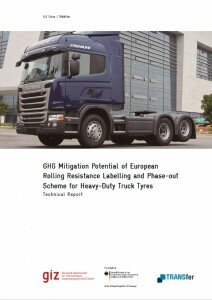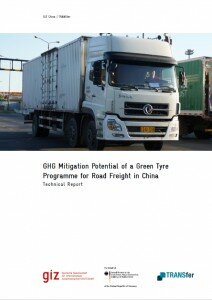 The transport sector is responsible for a great share of energy consumption, which directly correlates with the emission of polluting greenhouse gases (GHG) and therefore indirectly with climate change. Within this scope, road freight transportation accounts for the largest share of total GHG emissions from transport.
The transport sector is responsible for a great share of energy consumption, which directly correlates with the emission of polluting greenhouse gases (GHG) and therefore indirectly with climate change. Within this scope, road freight transportation accounts for the largest share of total GHG emissions from transport.
In Europe, in 2010, transport sector was responsible for 33 % of final energy consumption and 26 % of greenhouse gas emissions. Correlating, road transportation accounted for 72 % of total GHG emissions from transport. In China, in 2013, 14.19 million commercial road freight vehicles carried a total volume of 30.7 billion tonnes of freight with a turnover volume of 55.7 trillion ton kilometres. All of these figures grew with annual rates of over 10 % in the last years in China. Projections suggest that due to the development in e-commerce and globalisation road freight transport will increase significantly in the next few years.
As a consequence of these developments in Europe and China, a significant reduction of fuel consumption and GHG emissions resulting from road freight transport is required in order to meet climate change mitigation goals and to minimise final energy consumption. Measures to reduce fuel consumption of road freight vehicles can offer considerable savings potentials for both, fuel consumption and GHG emissions. As one of the major contributors to fuel consumption in road freight transport is rolling resistance of tyres (especially in case of heavy-duty trucks) one major strategy and cost efficient measure to reduce fuel consumption is to improve tyres and make “green tyres” a standard.
On this new basis, the European Union (EU) has introduced regulations for technical specifications of new tyres for all on-road vehicle types, including rolling resistance, wet grip and noise generation, in 2009. These laws contained a mandatory labelling for tyres (in classes) and phase-out regulations for tyres with high rolling resistance coefficients (RRC), aiming to speed-up the market penetration of low rolling resistance tyres.
Inspired by the discussion about tyre labelling regulations in the EU, China has started research on energy-efficient tyres in 2011. In 2014, China has introduced its first own standard for green tyres issued by the China Rubber Industry Association (CRIA). This standard is a technical standard for low rolling resistance tyres and has laid the foundation for China to implement a voluntary tyre grading and labelling system. The green tyre standard specifies three indexes similar to the European labelling methods for green tyre products, puts forward requirements on green tyres and specifies green tyres in terms of their life cycle.
Two countries, two studies – One approach, one goal
Now, GIZ project ‘Transfer of Climate Friendly Technologies and Measures’ (TRANSfer) which is funded through the International Climate Initiative (IKI) of the German Ministry of Environment (BMUB) has analysed with the support of IFEU Institute GHG savings potentials of efficient tyres in both, the EU and China, and has recently published two studies to support further development of low rolling resistance tyre regulations in China.
The first study assesses the fuel saving and GHG emission reduction potentials of the EU’s tyre labelling and phase-out regulations for European road freight transport. It is based on scenarios of future transport activities and specific fuel consumption, as well as most recent available data on actual rolling resistance of heavy-duty trucks in Europe.
The second study provides an ex-ante assessment of fuel and GHG emission savings potential of low rolling resistance tyres in China’s commercial road freight sector resulting from China’s Green Tyre programme. It is also based on most recent available data of future transport activities and specific fuel consumption of commercial trucks and developments of rolling resistance of truck tyres.
GHG mitigation potentials of Green Tyres
The two studies come to the conclusion that in the future improvements of fuel efficiency cannot compensate for the strong increase in transport activities in Europe and China. For that reason, total annual fuel consumption will increase (Europe: by 20 % from 2010 to 2030), as well as GHG emissions as a consequence (Europe: by 17 % from 2010 to 2030).
However, despite impossibility of stopping the increase of transport activities and fuel consumption, both studies clearly indicate that replacing old tyres by green tyres is linked to significant GHG savings potentials:
- In the EU, GHG savings potential from European tyre labelling and phase-out regulations can – in an ambitious scenario – reach up to 34 million tons CO2 per year. Therefore, total GHG emissions of heavy-duty truck transport in Europe from 2010 to 2030 will increase only by 4 % in this scenario instead of 17 % in the baseline scenario in which the absence of the regulations is assumed.
- In China, GHG savings potential from Chinese Green Tyre Programme can – also in an ambitious scenario – reach up to 219 million tons CO2 per year. Therefore, total GHG emissions of commercial trucks in China between 2010 and 2030 will increase in this scenario only by 156 % instead of 175 % in baseline scenario in which the absence of a Green Tyre Programme is assumed.
Even though new standards and regulations concerning improvements of tyres for road vehicles cannot compensate for the increase of vehicle kilometres being travelled (+295 % in China from 2010 to 2030) and the energy being consumed in the next years, they will significantly mitigate the GHG impact of road freight transport. Both study results clearly illustrate that the increase of future GHG emissions from commercial trucks could be considerably limited by the different standards and regulations.
In the next few years, further standards and regulations for tyre classification and labelling will be discussed in China and further work will be done to improve energy efficiency of the Chinese vehicle fleet.
For more detailed information and data on GHG mitigation potentials for truck tyres in road freight transport in the European Union and China please find the studies available as downloads below:

“GHG Mitigation Potential of European Rolling Resistance Labelling and Phase-out Scheme for Heavy-Duty Truck Tyres”
An assessment of the fuel saving and GHG emission reduction potentials of the EU’s tyre labelling and phase-out regulations for European road freight transport.

“GHG Mitigation Potential of a Green Tyre Programme for Road Freight in China”
An ex-ante assessment of fuel and GHG emission savings potential of low rolling resistance tyres in China’s commercial road freight sector resulting from China’s Green Tyre programme.
Picture Credit of Featured Image: Mateusz Stachowski via FreeImages.com




Comments are closed.